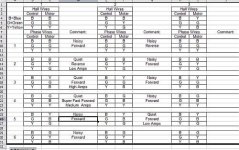Well, today I had a chance to test a theory brought on by an epiphany I had a while ago... You see, there are people in various sources on the web who say that to reverse the direction a brushless motor turns, one simply needs to swap any two power wires. Fine theory, but what about the sensor wires? Remember that model aircraft motors do not typically have sensors, whereas for some reason bicycle motors do. In any case, these sources indicate that if you swap the sensor wires in the same way, the motor will then rotate in reverse. Still a great theory. but for some reason that had never worked for me.
In any case, I wondered if maybe the reason was because the sensor wires are not colour-coded to coincide with the positions of the power wires. I was right! Today I looked a little more closely at a stator from a hub motor, and two of the three sensor wires (not including the two that deliver power to the sensors) were in opposite positions to the like-coloured power wires. In this case green sensor and power wires were in the same place, but yellow was opposite blue, and visa-versa. what all that meant is that if I switched the blue and yellow sensor wires, and the blue and yellow power wires, the motor did finally rotate backwards!
Now I'm left wondering though, why it is the motor makes more of a whine in reverse than going forwards. It still had speed and apparently had strength. Oh well, it will be fun to eventually connect a switch on my bike to two relays to make the bike go backwards. i'll have to be ginger with the throttle in reverse though!
In any case, I wondered if maybe the reason was because the sensor wires are not colour-coded to coincide with the positions of the power wires. I was right! Today I looked a little more closely at a stator from a hub motor, and two of the three sensor wires (not including the two that deliver power to the sensors) were in opposite positions to the like-coloured power wires. In this case green sensor and power wires were in the same place, but yellow was opposite blue, and visa-versa. what all that meant is that if I switched the blue and yellow sensor wires, and the blue and yellow power wires, the motor did finally rotate backwards!
Now I'm left wondering though, why it is the motor makes more of a whine in reverse than going forwards. It still had speed and apparently had strength. Oh well, it will be fun to eventually connect a switch on my bike to two relays to make the bike go backwards. i'll have to be ginger with the throttle in reverse though!


